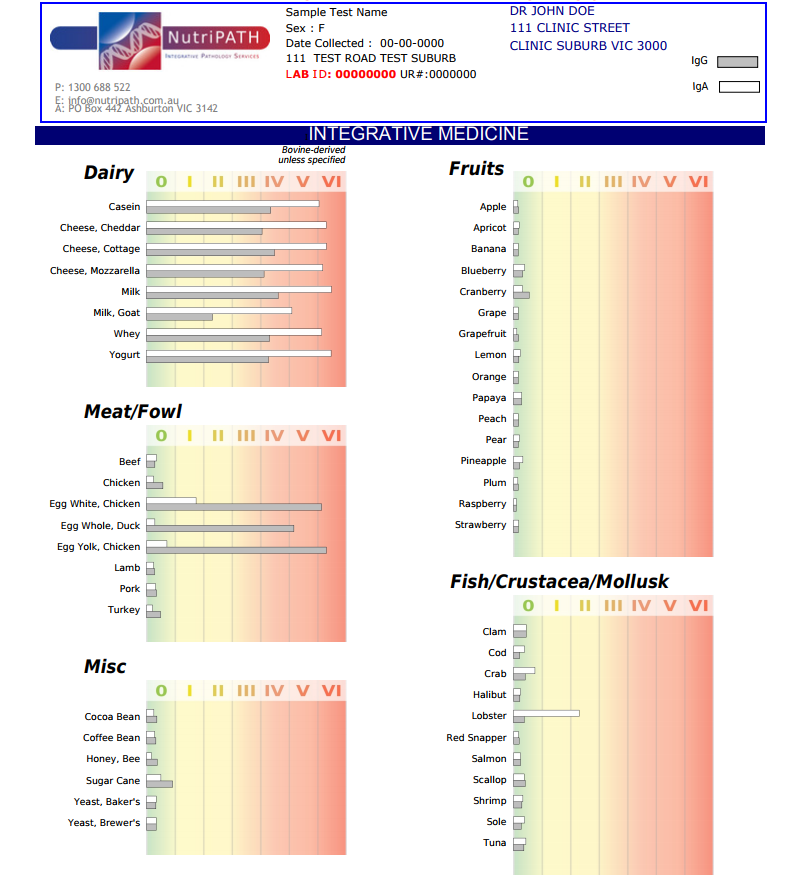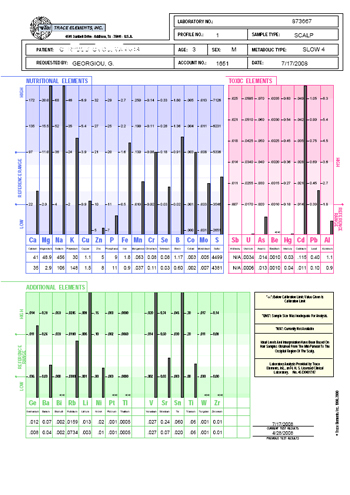What is Functional Pathology?

- Functional pathology tests are used to investigate functional, biochemical, nutritional, metabolic and hormonal status
- The results provide essential information to assist the practitioner in the diagnosis, treatment and management of patients seeking a holistic approach to health
- The tests are designed so patients can collect specimens in the privacy of their own homes
- Functional Pathology testing provides a tool for early intervention, management and monitoring of ongoing treatment efficacy
IgA/IgG Food intolerance and allergy testing – Sample report
Not sure if you have an allergy or an intolerance? Find out with the combination test. A small sample of blood – 12 dots of blood to be exact, and 10 days later you have your results. The current cost of the test is $350
3217-IgG-IgA-REPORT-with-food-diet-report
IgG Food Sensitivity Profiles
The majority of adverse reactions to food are rarely life threatening, but may be a source of considerable discomfort in many chronic conditions and diseases. The symptoms are varied and individuals can react in different ways. Many people live with minor or major symptoms of adverse food reactions for years without ever suspecting the involvement of the immune system and the foods which trigger them.
Food sensitivity reactions may be the result of enzyme deficiency, histamine releasing effects, altered intestinal permeabililty (e.g. leaky gut) or pharmacological effects.
Food sensitivity is often given a low priority in the investigation of disease. Common conditions where food sensitivity may play a significant role include bloating and fluid retention, inflammatory bowel disease, irritable bowel syndrome, migraine, depression and mood swings, asthma, skin conditions and behavioural problems in children.
IgG Food Sensitivity testing interpreted in relation to a case history and other test results, is an efficient and reliable method for diagnosing individuals with adverse reactions to food.
Food allergy, on the other hand, is an immunological adverse reaction to food which is often IgE-mediated and can be measured in most instances in blood by detection of specific antibodies. Food sensitivity is identified by screening blood samples for IgG antibodies to a panel of foods. The most common food sensitivities occur with cow’s milk, eggs, beans, nuts and cereals
List of foods: IgG_Food_Panels
whats the difference between an allergy and an intolerance: IgG_vs_IgE (6)
IgG sample report: IgGFoodSensitivityProfiles-IG (2)
Complete Digestive Stool Analysis (CDSA levels 1-5)
The Complete Digestive Stool Analysis (CDSA) is a functional test that provides an overview of the components of digestion, absorption, intestinal function and microbial flora, as well as identifying pathogenic bacteria, parasites and yeasts.
The CDSA is a non-invasive test providing invaluable information for the patient and practitioner in terms of understanding the role of poor digestive function in disease states.
Poor digestive function and imbalanced gut flora may play a crucial role in the underlying cause of a number of health conditions. Symptoms such as constipation, diarrhoea, flatulence, bloating, abdominal discomfort and bad breath are all indicative of poor gut function.
Information on the : CompleteDigestiveStoolAnalysis_CDSA_IG-1
Sample report :CompleteDigestiveStoolAnalysis_CDSA_SR-2 Report
MTHFR gene testing
The MTHFR gene, technically called Methylenetetrahydrofolate Reductase, is a key enzyme required to metabolise homocysteine.
WHAT IS THE CLINICAL RELEVANCE OF TESTING THE MTHFR GENE?
High homocysteine levels in the blood are recognised as a risk factor for:
- Coronary artery disease
- Venous thrombosis and stroke
- Type 2 Diabetes and

- Obesity
High homocysteine levels in the blood have also been associated with:
- Neural tube defects
- Recurrent miscarriage
- Autism Spectrum Disorders
- Stillbirths
- Depression and other mood disorders
The major cause of high homocysteine levels is folate deficiency. Other factors include insufficient vitamin B12 and genetic mutations in the MTHFR gene.
Intestinal Permeability (IP)
The Intestinal Permeability (IP) test, also referred to as a “leaky gut” test, is a precise and non-invasive method for assessing gastrointestinal mucosal integrity. Damage to the lining of the gastrointestinal tract (small and large intestine) is common in people with conditions such as food sensitivity and food allergy, irritable bowel syndrome, Crohn’s disease, arthritis, coeliac disease and dermatological conditions such as eczema, psoriasis and acne.
The lining of the gut wall is often subjected to a wide variety of insults from substances such as alcohol, caffeine, spices, medicines and environmental chemicals. The impact of chronic stress may also affect the permeability of the gut wall over time. Correcting the altered permeability may have an immediate effect on the relief of symptoms and facilitate the gradual improvement in the underlying condition.
The IP is a challenge test using Lactulose and Mannitol.
IntestinalPermeability_IP-SR report
Reverse T3 (rT3)
Thyroid hormones are essential in maintaining and regulating the body’s metabolism. Triiodthyronine (T3) is the most active of the thyroid hormones. Approximately 85% of circulating T3 is produced by monodeiodination of thyroxine (T4) in tissues such as liver, muscle and kidney. Selenium and zinc are required for this process.
Reverse T3 (rT3) is an inactive form of T3 that is produced in the body particularly during periods of stress. rT3 differs from T3 in that the missing deiodinated iodine is from the inner ring of the thyroxine molecule compared with outer ring on T3. rT3 is measured by a blood test.
Under normal conditions T4 will convert to both T3 and rT3 continually and the body eliminates rT3 quickly.
Under certain conditions, more rT3 is produced and the desirable conversion of T4 to T3 decreases. This occurs during fasting, starvation, illness such as liver disease and during times of increased stress.
This becomes a vicious cycle as rT3 competes with T3 as a substrate for the 5-deiodinase enzyme. This inhibits the conversion of T4 to T3, with more T4 being converted to more rT3.
An increased production of rT3 is often seen in patients with disorders such as fibromyalgia, chronic fatigue sydrome (CFS), Wilson’s Thyroid Syndrome and stress. Measurement of rT3 is also valuable in identifying sick euthyroid syndrome where active T3 is within normal range and rT3 is elevated.
Hair Mineral Analysis (HMA)
Hair mineral analysis (HMA) is a safe, non-invasive test that measures the levels and comparative ratios of nutrients and toxic metals found in hair. Hair mineral analysis can detect whether there is an excess or deficiency of vital nutrient minerals such as calcium, potassium, zinc and iron. It can also identify over-exposure to toxic metals such as aluminium, lead, arsenic and mercury. HMA is an invaluable screening tool in both every day and preventive health care.
This test provides a reading of the minerals deposited in the cells and interstitial spaces of the hair over a 2-3 month period. It does not provide an assessment of the mineral content of other tissues of the body. However, testing the hair can allow one to infer what is occurring in other tissues.



